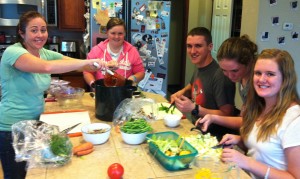W e started off the week making salsa. After picking all the remaining tomatoes from our garden (red and green), digging up a couple of onions, and picking the last of the cucumbers (because they were there), we set to work cutting everything up. Last year was our first salsa making experience and though it came out pretty good, I wanted to try a new recipe this year. A couple of months ago I had seen a post on The Homestead Fritz – How To Make Great Salsa; there he mentioned that his coworkers described it as, “the best salsa they have ever eaten.” With that recommendation, I decided we’d give it a try. With all six of us cutting stuff up: tomatoes, onions, pepper, jalepenos, garlic, cilantro, and cucumbers (again because we had them, figured it’d make it more chunky) the process went fairly quickly. After everything was mixed together and cooked up, Sarah and I spooned the salsa into the canning jars (we didn’t have pint size so we used quart jars — but with the size of our family those will go quickly). Since Fritz didn’t mention it, we weren’t sure how much it’d make. We followed his recipe (our only addition was the extra cup of cucumbers) and we came out with three quarts of salsa, plus one 1/2 pint jar (that we gave as a gift to friends). Next year we’ll double it (or even triple, we like salsa), and use the pint size jars so we can share more with friends and neighbors.
e started off the week making salsa. After picking all the remaining tomatoes from our garden (red and green), digging up a couple of onions, and picking the last of the cucumbers (because they were there), we set to work cutting everything up. Last year was our first salsa making experience and though it came out pretty good, I wanted to try a new recipe this year. A couple of months ago I had seen a post on The Homestead Fritz – How To Make Great Salsa; there he mentioned that his coworkers described it as, “the best salsa they have ever eaten.” With that recommendation, I decided we’d give it a try. With all six of us cutting stuff up: tomatoes, onions, pepper, jalepenos, garlic, cilantro, and cucumbers (again because we had them, figured it’d make it more chunky) the process went fairly quickly. After everything was mixed together and cooked up, Sarah and I spooned the salsa into the canning jars (we didn’t have pint size so we used quart jars — but with the size of our family those will go quickly). Since Fritz didn’t mention it, we weren’t sure how much it’d make. We followed his recipe (our only addition was the extra cup of cucumbers) and we came out with three quarts of salsa, plus one 1/2 pint jar (that we gave as a gift to friends). Next year we’ll double it (or even triple, we like salsa), and use the pint size jars so we can share more with friends and neighbors.
My good friend, and fellow prepper, Mike recently gave us the book, So Easy To Preserve put out by the Cooperative Extension of The University of Georgia. Since we have very limited canning experience (blackberry jam and salsa last year) it came in handy reminding us of the steps involved in the water bath method. It’s a good reference book that thoroughly covers: canning, pickling, jellies, freezing, and drying.
Inadvertently, you could also call it busy or lazy, we had a small test of our store what your eat (SWYE) food storage. We normally shop every two weeks. Well life got busy, we missed a shopping trip, and we went a full month without grocery shopping. It’s interesting that with our food storage we really didn’t notice it all that much. Sure we were missing the items that have shorter shelf lives: fresh fruit, most fresh vegetables (though we were able to add some from our garden), and milk. Since we’re not big milk drinkers we’d just mix up some of the powdered stuff when we needed to add it to a recipe. Another item we would have been out of is eggs, but we have a local farm source that we get them from regularly so we didn’t go without. It was interesting how uninterrupted our daily food supply was; between our SWYE pantry and our deep freezer we had plenty. It’s nice to know that if we HAD to go that long it wouldn’t be an issue at all; that alone gives us a certain feeling of safety and confidence.
 I’m happy to announce our fourth (and most likely final) regular blog contributor, Nick. Nick is a general contractor and a prepper who specializes in “Sustainable Improvements, Repairs, and Installations“. He will be posting the fourth Wednesday of each month (starting next week, October 24th), focusing on what we can do to make our homes more sustainable and keep them in good repair — from a prepper perspective. I’ve now completed one of my goals for my second year of blogging, to have a guest contributor for each week:
I’m happy to announce our fourth (and most likely final) regular blog contributor, Nick. Nick is a general contractor and a prepper who specializes in “Sustainable Improvements, Repairs, and Installations“. He will be posting the fourth Wednesday of each month (starting next week, October 24th), focusing on what we can do to make our homes more sustainable and keep them in good repair — from a prepper perspective. I’ve now completed one of my goals for my second year of blogging, to have a guest contributor for each week:
- Week 1 – Rural Relations with Josh
- Week 2 – Sarah’s View
- Week 3 – Momma Bear
- Week 4 – Nick
These four share really good, and varied, perspectives–different than I’m able to provide–that I believe will add value to both my blog and the prepper community. For more information about each of them, and a list of the posts they’ve written, there’s a link to Guest Contributors in the top right hand portion of the Home page.
Finally, I want to congratulate two of my closest prepper friends on additions to their families. From our prepper coffee group, both Mike and Rick had newborn sons this month! They’re both great dads who I know will raise their kids up to be “properly” educated, self-sufficient, and independent.
What did you do?



